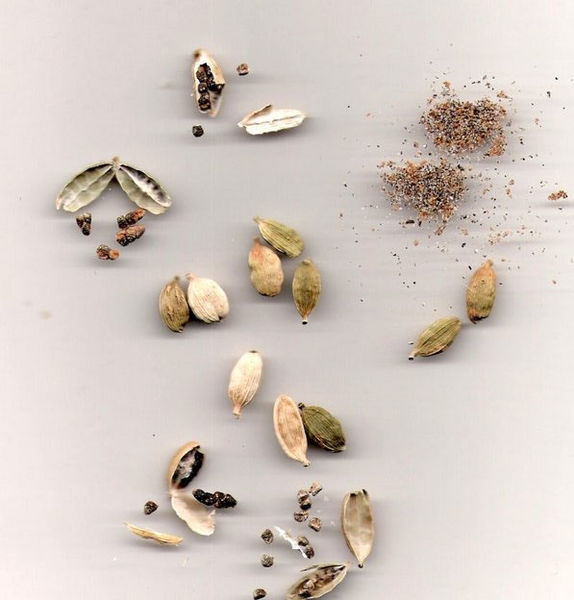Cardamom

Green cardamom seeds and seed pods
The Basics
Cardamom is the pale, green seed pod taken from a shrub in the ginger family. Like many other spices cardamom comes from more than one individual species. There are two main types (okay, genera if you appreciate technicalities) of ginger plants that provide cardamom: Elettaria and Amomum. The former is called green or true cardamom and grows from India to Malaysia, the latter is brown or black cardamom and is found through Asia and Australia.
The Form
The pods are harvested just before they open and resemble triangular tubes. The outer shell has a papery texture and the inside seeds are small, black and fragrant. You can use the entire pod, the crushed outer layer or grind the seeds with a mortar and pestle or spice/coffee grinder.
The Flavor
Cardamom has a distinct warm, sweet, pungent aroma. Toasted, ground, or in its whole form: cardamom’s versatility is incredible as it infuses a complementary flavor into a wide variety of edibles. Curries, breads, desserts, curries, rice, tea and coffee are some of the pairings.
Cardamom loses its flavor and aroma quickly. It’s best to purchase it in its whole form and grind what you need when you need it. Even the pods will lose up to 40 percent of their potency their first year in storage.
Cardamom is common in Indian cooking and is a main ingredient in garam masala and chai masala. In the Middle East cardamom is infused with coffee. The Scandinavians add it to their baked goods (the Vikings discovered cardamom in Constantinople and brought it home where it was a huge hit). In North Africa cardamom is part of a spice blend called Ras-al-Hanout which is used to flavor everything from rice to meats.
The Story
For the Arabs, cardamom is a symbol of hospitality. They will serve coffee brewed with one or two cardamom pods infusing the cofee with its distinct flavor and good wishes. Using cardamom is a generous gesture as it is one of the world’s most expensive spices, second only to saffron.
The Greeks and Romans were more practical. The Greeks chewed cardamom as a tooth cleaner and the Romans used it as an aromatic ingredient in their perfume.
Health Benefits
Since ancient times people have turned to cardamom for health benefits. Greeks, Romans and Egyptians used it as an aphrodisiac. Today people use it as a weight-loss aid (increases metabolism). Cardamom also is used to help digestion and chewing the pods may help relieve coughing. It’s also popular in tea where it’s used as a detoxifier and to help nausea.
Sources:
Arokiasamy, Christina. The Spice Merchant’s Daughter: Recipes and Simple Spice Blends for the American Kitchen
www.teabenefits.com
www.wikipedia.com
Try It!
Give it to me NOW! If you love chocolate and want chocolate infused with cardamom click here to satisfy your craving (it’s so worth it). No cooking necessary.
If you’re willing to put out a little more effort try this:
Chocolate Cardamom Cake
8 oz. fine-quality bittersweet chocolate
1 cup (2 sticks room temperature butter)
1/2 cup confectioner’s sugar (plus more for dusting)
4 large eggs, separated and room temperature
1/2 teaspoon fresh ground cardamom
1/2 cup all-purpose flour, sifted
1. Preheat oven to 350 degrees F. Lightly butter and flour five 6-ounce ovenproof ramekins. 2. Melt chocolate in a double boiler (if you don’t have one use a heat-proof bowl and place in a pan with a few inches of simmering water. Stir until melted). Set aside. 3. In a mixer beat butter and sugar. Add yolks one at a time and continue to beat until doubled in volume. Add cardamom and beat for 1 minute. 4. Stir in melted chocolate and beat for 1 minute. Fold in flour and mix until combined. 5. Whip egg whites to stiff peaks. Fold gently into cake mixture until smooth. Spoon into prepared ramekins then place on baking sheet. Bake for 30 minutes. A toothpick should come out with moist crumbs still attached. 6. Cool cakes completely on a rack. Dust with confectioner’s sugar.




13 Pingbacks